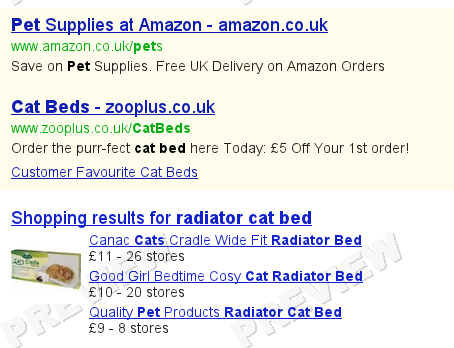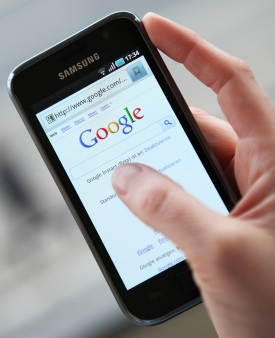It can be tough to work out how well mobile traffic converts, especially if you have an ecommerce site. Purchasing on a mobile is more difficult than it is on a computer, so this puts people off. We want to feel comfortable and secure when purchasing on a mobile device.
For example, Keith decides he wants to buy a new radiator cat bed for his handsome, prize winning British Shorthair. He pulls out his mobile and performs the following search in Google – “radiator cat beds”. Keith is delighted at the range of sites advertising to him:


He looks at all the sites in detail and decides who he wants to buy from, aided by some reassuring meows from his beloved feline. However, he doesn’t feel comfortable buying on his mobile because its fiddly and there’s more chance of making a mistake. So he puts his mobile down and goes to his laptop, then types the URL of the chosen supplier into his browser. He clicks the clients paid brand ad and buys his cat bed. On the next months report, the sale will be recorded as PPC – Brand, and the value of that initial mobile search of “radiator cat beds” is lost.
For the search agency running the PPC account, they face some difficult questions about the performance of the mobile campaign, when it looks like performance levels are not what they should be. At the heart of this is ultimately a tracking problem. Keith’s mobile and laptop both contain cookies from the cat bed suppliers site, but because they aren’t linked together, his overall customer journey is lost. The mobile visit appears to be a wasted click, and the computer visit appears to be a click from someone who may have already known about the company anyway.
Conversion rates are generally lower on mobile devices, and this can lead people to make bad decisions on the quality and value of the traffic they attract. Its better to consider a keyword to be just as valuable on a mobile search as it is on a computer based search. Its the same keyword so why should it be worth less on a different device?
The best strategy for a company is to make your site as mobile friendly as possible, or create a specific website just for mobile traffic. You will probably still see a lower conversion rate than your computer based traffic, but you can bridge the gap quite significantly.
Here’s a case study from a long term Search Laboratory client (with their permission of course).
Beads Direct Go Mobile – Shop for Beads on the Go
Online shopping behaviour is changing and more consumers are using their mobile to shop on the go. As market leaders in the craft sector Beads Direct identified a need to cater for their mobile shoppers and begun development work on their website to do just that. Beads Direct see mobile as a key aspect of their digital strategy so their approach to mobile optimisation was carefully planned and executed. Beads Direct launched their mobile optimised and enhanced website in late December after a complete website rebuild.
The new responsive website changes to fit to the size of your screen for optimal performance on a desktop, tablet or mobile phone. On a small mobile phone screen the layout changes so buttons are easy to press with your finger instead of your mouse. Some of the features include:
- Design gallery with the ability to add all products needed for a design to your shopping basket in one click
- Navigation by category, colour, shape and brand
- Filters to narrow down results and find just what you need
- Simple shopping basket with your savings clearly displayed
- Social sharing so you can like, pin and tweet products in an instant
Beads Direct have also worked with Worldpay and Paypal to ensure they are offering optimised payment pages, making payment quick and easy too. The site will continue to develop in 2013, with plans to integrate independent reviews from Feefo and to introduce a live chat service to help answer customer queries more quickly.
Marketing Manager Claire Humpherson said:”Going mobile was a big project for us. We worked hard to complete the changes ready for our January sale rush. We wanted to make purchasing from our website on a mobile device easy and stress-free”.
Results so far
Site performance has improved since the changes, while we can’t share exact statistics, site engagement has increased by 10% and mobile sales are up.
The client has fully embraced the benefit of having an optimised mobile site, and they will continue to reap the rewards in a climate where even the smallest advantage can mean the difference between being a market leader or follower.
Our advice is to make every effort to optimise your site for a mobile device, because many of your competitors are probably already doing it. Having a competitive advantage is, now more than ever, such an important aspect for any ecommerce business.

